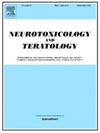Pregnancy outcomes following maternal exposure to favipiravir: A Terafar case series
IF 2.8
3区 医学
Q3 NEUROSCIENCES
引用次数: 0
Abstract
Objective
To assess pregnancy outcomes following maternal favipiravir exposure, with a particular focus on congenital malformations and neonatal development.
Methods
A case series, including data from pregnancies with favipiravir exposure between 2020 and 2021, was conducted at Izmir Katip Celebi University Teratology Information Center. Pregnant women and their infants were evaluated through structured interviews, ultrasonography, neonatal follow-ups, and developmental assessments. Congenital malformations were classified per EUROCAT criteria, and development was assessed using the Denver Developmental Screening Test-III.
Results
Of 45 pregnancies, 37 resulted in live births (including 1 set of twins), seven were electively terminated, and one ended in intrauterine death. Among the 28 infants with first-trimester exposure, 7.1 % (n = 2) had major malformations (congenital ichthyosis and hydronephrosis) and an additional 7.1 % (n = 2) had minor malformations (pleural effusion, patent foramen ovale). A review of exposure windows relative to critical developmental periods did not indicate a consistent or conclusive temporal association with the observed anomalies. Preterm birth and low birth weight rates were 9.6 % and 6.4 %, respectively. Neonatal jaundice occurred in 32.2 % of neonates. Developmental screening was normal in most cases, with one infant—who did not have any congenital malformations—exhibiting mild language delay.
Conclusion
Our study does not indicate a major teratogenic signal regarding favipiravir exposure in pregnancy, though the higher elective termination rate suggests increased risk perception. While study limitations prevent definitive conclusions, our findings may be of value to clinicians in counseling pregnant women regarding favipiravir exposure.
孕妇接触法匹拉韦后的妊娠结局:特拉法病例系列
目的评估孕妇法匹拉韦暴露后的妊娠结局,特别关注先天性畸形和新生儿发育。方法在Izmir Katip Celebi大学畸形学信息中心进行了一系列病例研究,包括2020年至2021年期间接触favipiravir的妊娠数据。通过结构化访谈、超声检查、新生儿随访和发育评估对孕妇及其婴儿进行评估。根据EUROCAT标准对先天性畸形进行分类,并使用丹佛发育筛查测试- iii评估发育。结果45例妊娠中,37例活产(包括1对双胞胎),7例选择性终止妊娠,1例宫内死亡。在28名妊娠早期暴露的婴儿中,7.1% (n = 2)有严重畸形(先天性鱼鳞病和肾积水),另外7.1% (n = 2)有轻微畸形(胸腔积液,卵圆孔未闭)。对与关键发育时期相关的暴露窗的回顾并没有表明与观察到的异常有一致或结论性的时间关联。早产和低出生体重率分别为9.6%和6.4%。新生儿黄疸发生率为32.2%。发育筛查在大多数情况下是正常的,有一个没有任何先天畸形的婴儿表现出轻微的语言迟缓。结论:我们的研究并未表明妊娠期接触法匹拉韦有主要的致畸信号,尽管较高的选择性终止率表明风险认知增加。虽然研究的局限性阻止了明确的结论,但我们的研究结果可能对临床医生就favipiravir暴露对孕妇进行咨询有价值。
本文章由计算机程序翻译,如有差异,请以英文原文为准。
求助全文
约1分钟内获得全文
求助全文
来源期刊
CiteScore
5.60
自引率
10.30%
发文量
48
审稿时长
58 days
期刊介绍:
Neurotoxicology and Teratology provides a forum for publishing new information regarding the effects of chemical and physical agents on the developing, adult or aging nervous system. In this context, the fields of neurotoxicology and teratology include studies of agent-induced alterations of nervous system function, with a focus on behavioral outcomes and their underlying physiological and neurochemical mechanisms. The Journal publishes original, peer-reviewed Research Reports of experimental, clinical, and epidemiological studies that address the neurotoxicity and/or functional teratology of pesticides, solvents, heavy metals, nanomaterials, organometals, industrial compounds, mixtures, drugs of abuse, pharmaceuticals, animal and plant toxins, atmospheric reaction products, and physical agents such as radiation and noise. These reports include traditional mammalian neurotoxicology experiments, human studies, studies using non-mammalian animal models, and mechanistic studies in vivo or in vitro. Special Issues, Reviews, Commentaries, Meeting Reports, and Symposium Papers provide timely updates on areas that have reached a critical point of synthesis, on aspects of a scientific field undergoing rapid change, or on areas that present special methodological or interpretive problems. Theoretical Articles address concepts and potential mechanisms underlying actions of agents of interest in the nervous system. The Journal also publishes Brief Communications that concisely describe a new method, technique, apparatus, or experimental result.

 求助内容:
求助内容: 应助结果提醒方式:
应助结果提醒方式:


